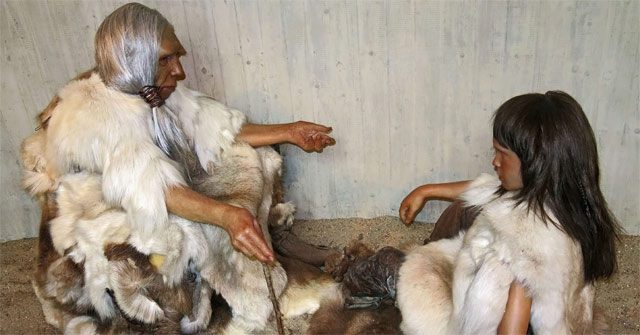In the ancient times, when humans began to stand upright, “the cradle of humanity” in Africa enjoyed a perfect climate, allowing our ancestors to go without clothing for warmth, and they didn’t need thick fur like many other animal species. However, to conquer new lands from Europe to Asia, there were times when our ancestors had to use animal skins from their hunts to cover themselves for warmth.

According to archaeologists, the earliest evidence that our ancestors were not “naked” was found in archaeological sites such as Gran Dolina in the Atapuerca Mountains of Spain, linked to the Homo antecessor species dating back about 780,000 years. Other evidence was discovered in Schöningen, Germany, related to Homo heidelbergensis. In Germany, archaeological findings indicate that at least 400,000 years ago, upright humans were already processing animal skins to create clothing.
By the Neanderthal era, dating back approximately 400,000 years to about 40,000 years ago, archaeologists discovered muscle structures in the forearms and upper arms of Neanderthals that suggest they frequently draped skins over their bodies. Despite having a body better adapted to cold than modern humans (Homo sapiens), a study in 2012 showed that Neanderthals had to cover up to 80 percent of their body surface to survive harsh winters.
Today, during winter, we wear clothing that covers 90 percent of our body, often layering multiple garments to stay warm. The human use of clothing is further supported by a study from 2011, which revealed that lice found on clothing mutated from head lice around 170,000 years ago. This implies that humans began wearing clothes made from various materials, not just animal skins for warmth.
More specifically, according to Wikipedia, Ralf Kittler, Manfred Kayser, and Mark Stoneking, anthropologists at the Max Planck Institute for Evolutionary Anthropology, conducted genetic analyses of lice on humans indicating that clothing originated around 170,000 years ago. Body lice are a sign of clothing use, as most humans have sparse body hair, thus lice relied on human clothing for survival. Their research suggests that the invention of clothing may coincide with the migration of modern Homo sapiens northward from the warm climates of Africa, believed to have started between 50,000 to 100,000 years ago. However, a second research group using similar genetic methods estimates that clothing originated about 540,000 years ago.
According to archaeologists and anthropologists, the earliest garments may have included furs, hides, leaves, or grasses wrapped or tied around the body. Knowledge of such clothing remains speculative, as clothing materials degrade far more quickly than artifacts made of stone, bone, shell, and metal. Archaeologists have identified early sewing needles made from bone and ivory, dating back about 30,000 years, discovered near Kostenki, Russia, in 1988. Dyed flax fibers that could have been used in clothing were found in a prehistoric cave in Georgia, dating back 34,000 years.
Additional archaeological evidence suggests that around 40,000 years ago, humans knew how to use sewing needles made from bone and stone to stitch together pieces of leather for a better fit, improving warmth efficiency.


















































